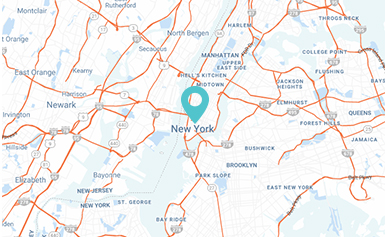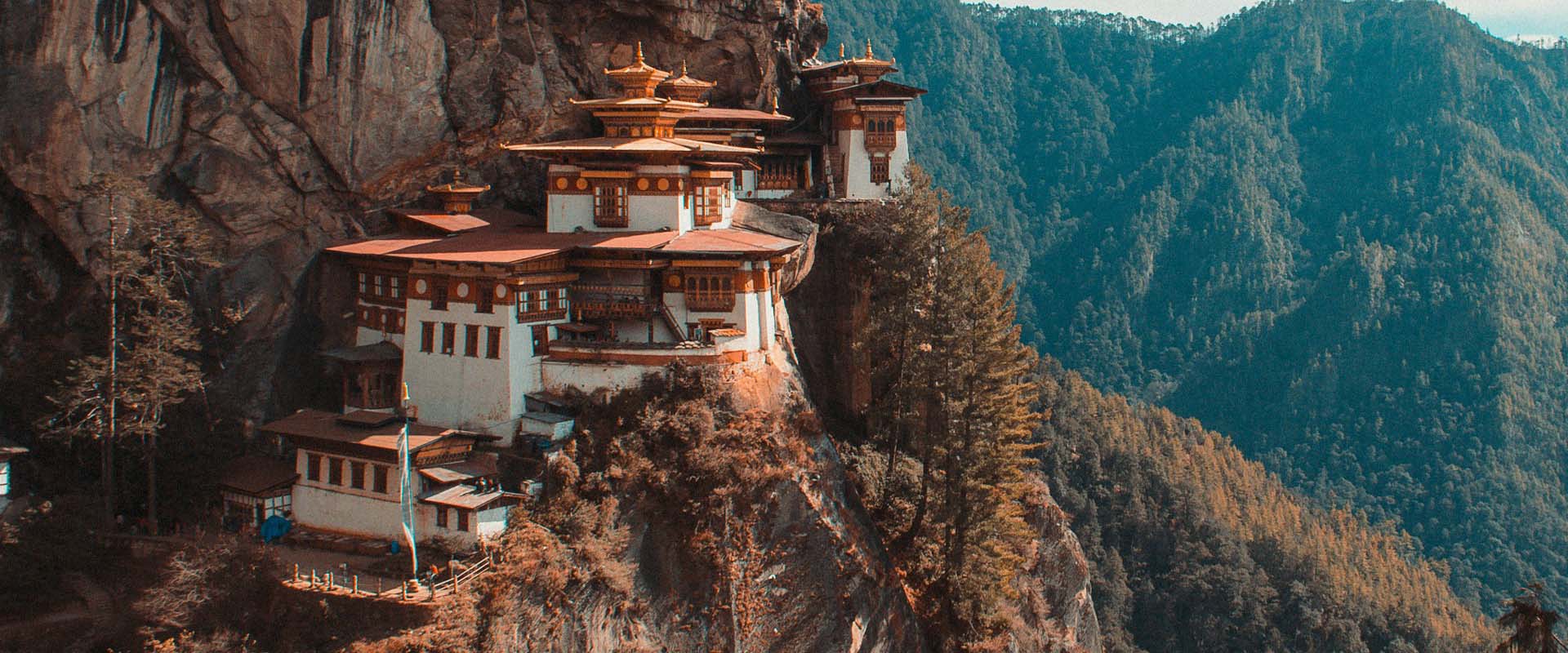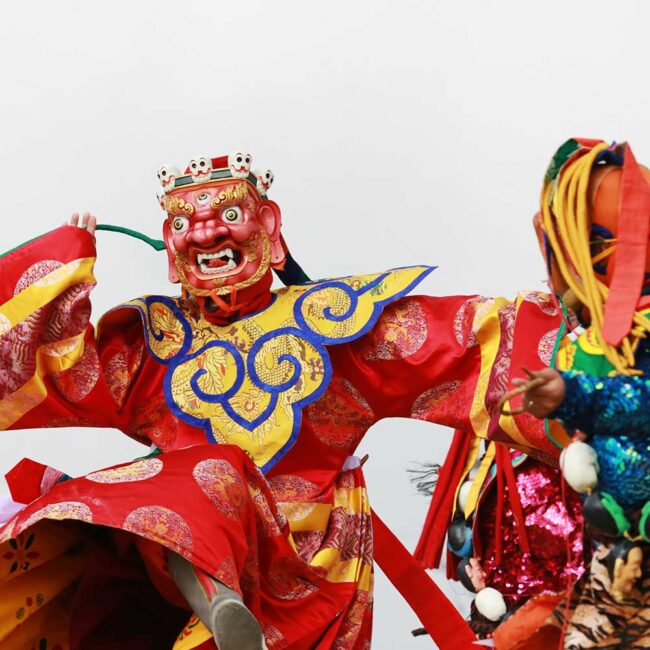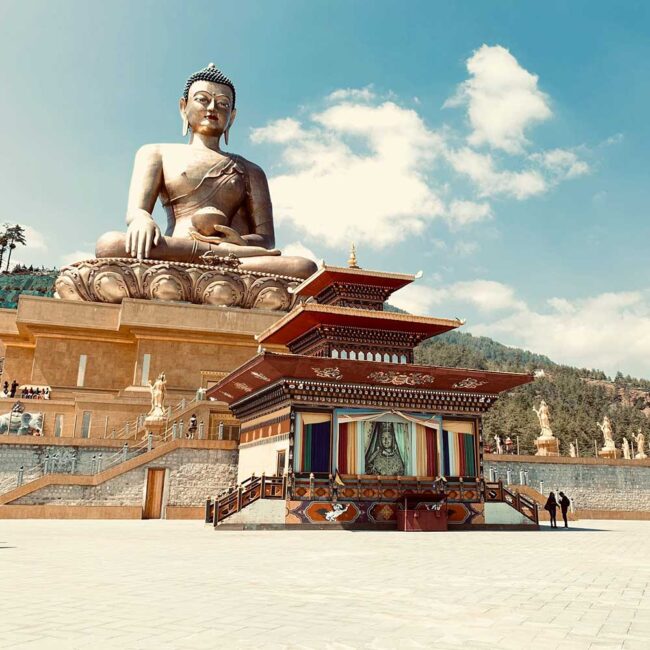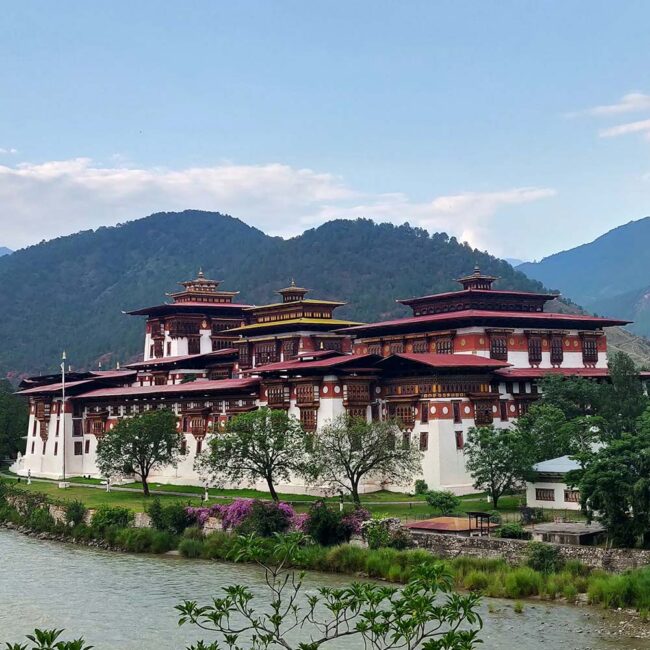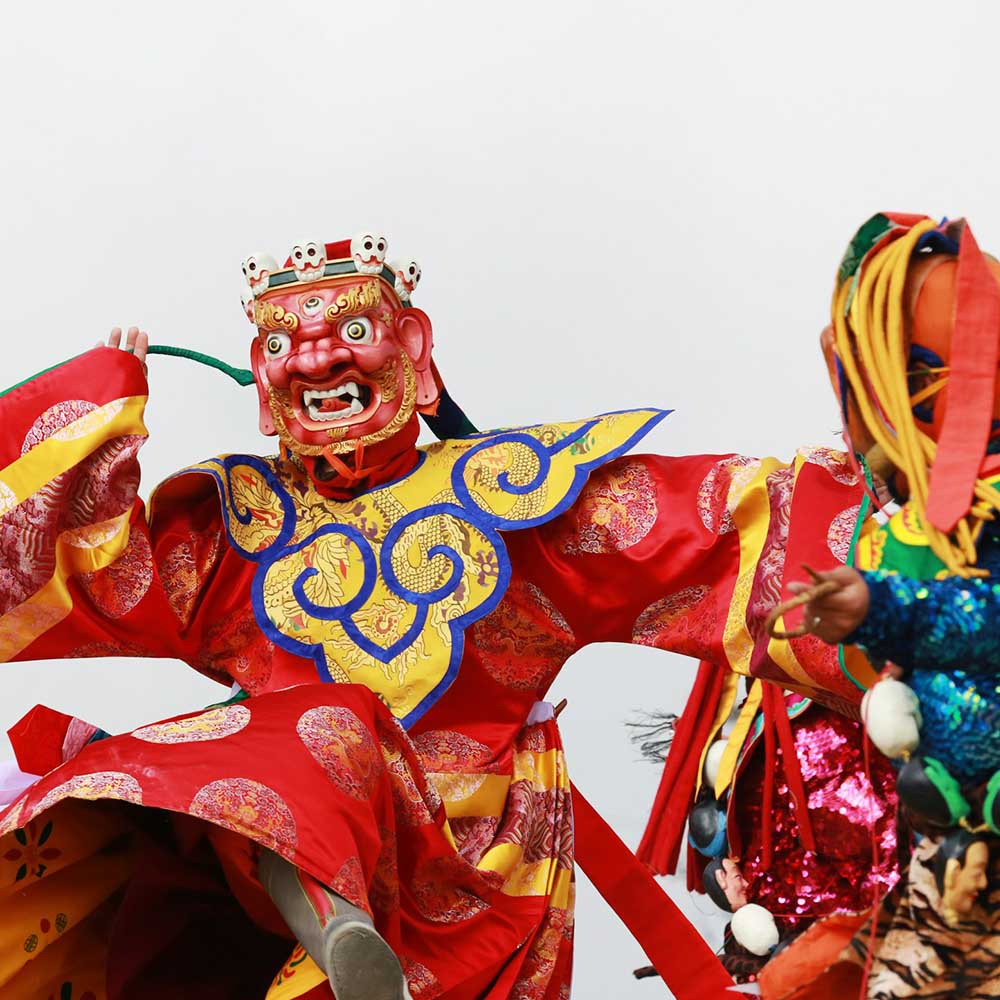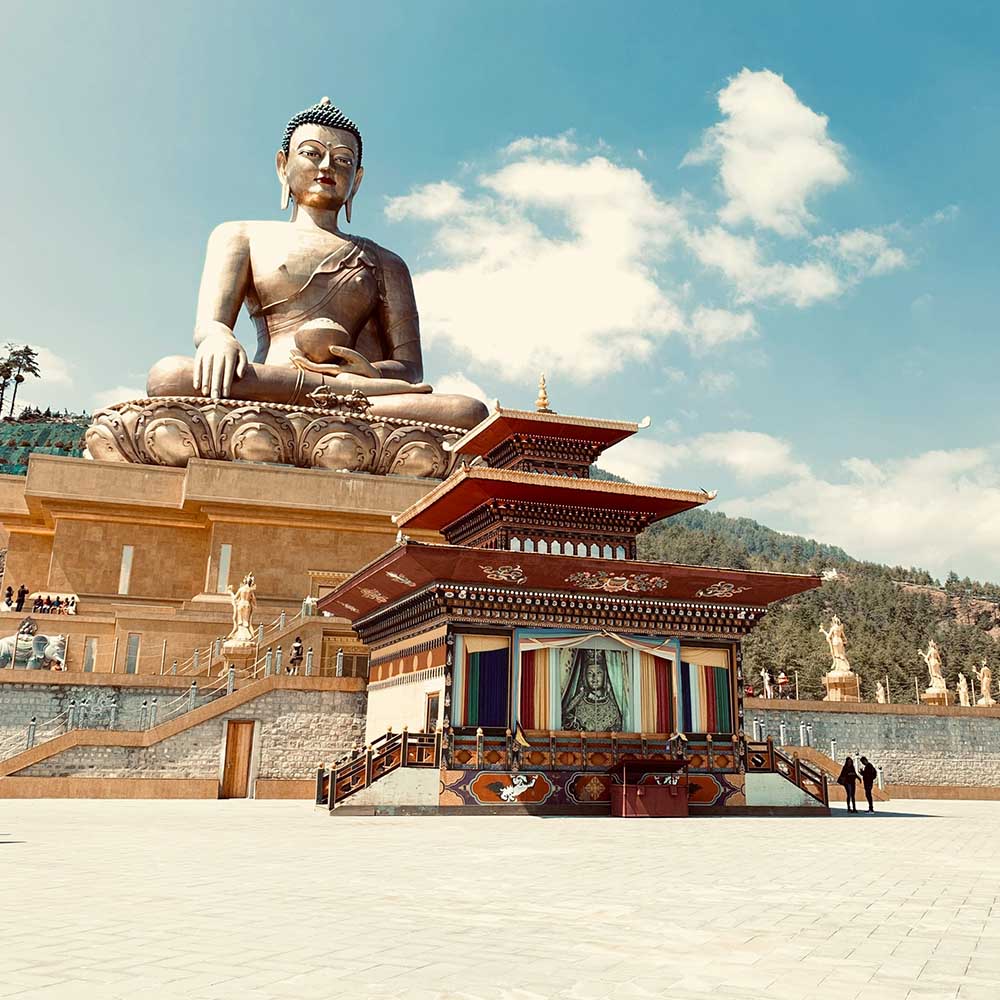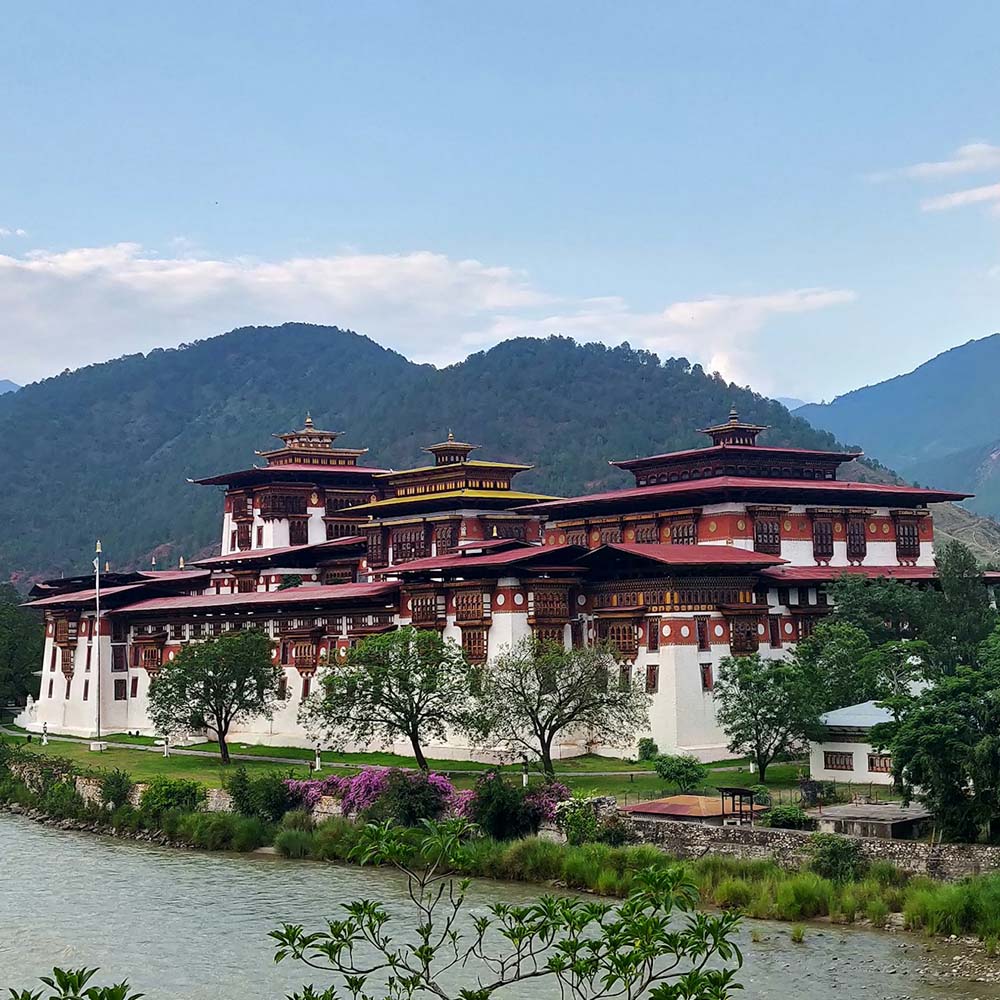7 Days in Bhutan – Happiness is a Place!
/ per person
(0 Reviews)
7 Days in Bhutan – Happiness is a Place!
2 Nights Thimphu, 2 Nights Punakha and 2 Nights Paro
-
Included
5 Star AccommodationAirport TransferBreakfastPersonal Guide -
Not Included
Gallery TicketLunchSample AAA
Tour Plan
1
Day 01: Arrive Paro by Flight & transfer to Thimphu (55km, approx. 1.1/2-hour drive)
The flight to Paro is one of the most spectacular in entire Himalayas. Whether flying along the Himalayan range from Kathmandu or over the foothills from Kolkata, the journey offers fascinating views and an exciting descent into the Kingdom. Bhutan’s first gift as you disembark from the aircraft will be cool, clean fresh mountain air. After immigration formalities and baggage collection, you will be met by our representative, and afterwards drive to Thimphu, the capital town of Bhutan with en-route stop at Chuzom, the confluence of Thimphu and Paro rivers. Three different styles of stupas; Tibetan, Nepalese and Bhutanese adorn this confluence.
On arrival, in Thimphu check-into the hotel. The capital town of Bhutan and the centre of government, religion and commerce, Thimphu is a unique city with unusual mixture of modern development alongside ancient traditions. It is perhaps still the world’s only capital city without a traffic light.
Evening an exploratory walk around Thimphu main street and market area.
Overnight at the hotel in Thimphu (Altitude 2,320 m).
2
Day 02: Thimphu
After breakfast, drive to visit Buddha Dordenma, located atop a hill in Kuenselphodrang Nature Park and overlooks the Southern entrance to Thimphu Valley. The statue fulfils an ancient prophecy dating back to the 8th century A.D that was discovered by Terton Pema Lingpa (Religious Treasure Discoverer) and is said to emanate an aura of peace and happiness to the entire world. This massive statue of Shakyamuni made of bronze and is gilded in gold, measures 51.5 meters in height, making it one of the largest statues, in Bhutan. 125,000 smaller Buddha statues have been placed within the Buddha Dordenma statue, each of these also have been cast in bronze and gilded. The throne that the Buddha Dordenma sits upon is a large meditation hall.
Then, visit King's Memorial Chorten continuously circumambulated by people, murmuring mantras and spinning their prayer wheels. Construction of this landmark was the idea of Bhutan’s third king, His Majesty Jigme Dorji Wangchuk (“the father of modern Bhutan”) who has wished to erect monument to world peace and prosperity. Completed in 1974 after his untimely death, it serves both as a memorial to the Late King and as a monument to peace.
Afternoon the visits include:
Textile Museum: Bhutanese textiles are an integral part of its culture and heritage and are unique for their diversity and sophistication. Textile Museum at Thimphu has given a new platform to the nation’s textiles and Bhutanese weavers and boasts of an invaluable collection of antique textile artifacts of Bhutan. The museum has opened its exhibition on six major themes - warp pattern weaves, weft pattern weaves, role of textiles in religion, achievements in textile arts, textiles from indigenous fibers and the royal collections.
Folk Heritage Museum: The Museum is dedicated to connecting people with the rich Bhutanese Folk heritage and rural history through exhibits, demonstrations, educational programs and documentation of Bhutanese rural life.
Trashichhoedzong: This is the center of government and religion, site of monarch’s throne room and seat of Je Khenpo or Chief Abbot. Built in 1641 by the political and religious unifier of Bhutan, Zhabdrung Ngawang Namgyal, it was reconstructed in 1960s in traditional Bhutanese manner, without nails or architectural plans.
Evening time can be spent strolling through Thimphu city centre and local crafts bazaar, to browse through example of Bhutan's fine traditional arts. Here you can buy hand-woven textiles, thangkha paintings, masks, ceramics, slate and wood carvings, jewelry, interesting items made from local materials.
Overnight at the hotel in Thimphu (Altitude 2,320 m).
3
Day 03: Thimphu – Punakha & Wangdue (75 km, approx. 3 hours’ drive)
After breakfast, explore Centenary Farmers Market of Thimphu. One of the largest domestic markets, it was built in 2008 to mark the coronation of fifth king of Bhutan and hundred years of monarchy. This two storied building has 458 stalls for the sale of vegetable, fruits, meat, farm products. Many stalls here also contain beautifully handcrafted items such as yak tail dusters, butter teacups and other attractive household items.
Then drive to Punakha / Wangduephodrang across Dochu La Pass. Located at a height of 3,088m/ 10,130 ft, Dochula is a scenic location with chorten, mani wall, and prayer flags which decorate this highest point on the road. If skies are clear, it may be possible to see the following
peaks from this pass in the order left to right: Masagang (7,158m), Tsendagang (6,960m), Terigang (7,060m), Jejegangphugang (7,158 m), Kangphugang (7,170 m), Zongphugang (7, 060 m), a Table Mountain that dominates the isolated region of Lunana - finally Gangkar puensum, the highest peak in Bhutan at 7,570m.
At Dochula Pass, 108 chortens or stupas known as Druk Wangyal Chortens have been built by Ashi Dorji Wangmo Wangchuk, the eldest Queen Mother. These chortens are built in three layers, the first lowest level layer has forty-five chortens, the second has thirty-six and the top layer has twenty-seven, built around the main chorten.
Also visit at Dochula pass Druk Wangyal Lhakhang (temple), built in honour of His Majesty the fourth Druk Gyalpo, Jigme Singye Wangchuck. The past and future appears to merge in the details of the temple and its structure tells the story of a supreme warrior figure, whose vision pierces the distant future in a fine blend of history and mythology.
Post lunch visit Wangduephodrang Dzong. Founded by Zhabdrung Ngawang Namgyal in 1638, on the top of high ridge between Punak Tsang Chhu and Dang Chhu rivers, offering fantastic of the valley below, Wangdue Dzong holds special place in Bhutan’s history. The strategic location of the dzong, provided Penlop (Governor) of Wangduephodrang, chance to protect the routes to Trongsa, Punakha, Dagana and Thimphu making him the third most powerful ruler after Governors of Paro and Trongsa. The Dzong had been damaged by fire in 2012 and restored to its original grandeur and splendour recently (in 2022).
Then explore Punakha Suspension Bridge. One of the oldest and longest suspension bridges of Bhutan measuring about 160 meters is built over Pho Chhu river and located near the iconic Pungthang Dechen Phodrang Dzong, connecting Dzong with Punakha town and the scattered villages. Believed to be built by Thangtong Gyalpo, a pioneering engineer who introduced the construction of suspension bridges into Bhutan and Tibet, this bridge has undergone several renovations since then. Its enthralling experience walking over the bridge, decked with vibrant prayer flags and enjoying awe-inspiring view of the valley, surrounding mountains and the river.
Later in the afternoon visit Punakha Dzong or (Palace of Great Happiness), built in 1637 by Zhabdrung Ngawang Namgyal, at the junction of the Phochu and Mochu rivers. This majestic dzong served as both the religious and the administrative center of Bhutan in the past. It measures some 600 by 240 feet and has a six-story, gold-domed tower. Inside are courtyards and religious statuary that hint at the depth of history and spiritual tradition embodied here. Your guide will illuminate your understanding of this intricate culture that is exotic to us, though long established here.
Overnight at the hotel in Punakha / Wangdue (Altitude 1,300m).
4
Day 04: Punakha & Wangdue
After breakfast, a beautiful hike (total about 2 hours round trip walk) takes you to the regal Khamsum Yuelley Namgel Chorten, which was built by the Queen Mother of Bhutan to remove negative forces and promote peace, stability and harmony in the changing world. The Chorten dominates the upper Punakha Valley with commanding views across the Mo Chhu river and up towards the mountainous peaks of Gasa and beyond.
Afternoon excursion to Talo village. The village of Talo (altitue 2,800m) which is scattered along the hill slopes, known for its cleanliness and hygiene among Punakha villages. Talo Sangnacholing is built on a plateau and has majestic view of surrounding villages. The beautiful farmhouses of the village have its own flower gardens, and, on the hill, slope corns and sweet peas are grown in abundance. Take a stroll in this lovely village.
While return to town , on the way visit Sangchhen Dorji Lhuendrup Lhakhang Nunnery. Perched on a ridge amid pine trees and overlooking valleys of Punakha and Wangdue gleams Sangchhen Dorji Lhuendrup temple. It houses a 14-foot main bronze statue of Avalokiteshvara and of Guru Padsambhava, Gautam Buddha, Zhabdrung Ngawang Namgyal, Tsela Namsum, the 21 Taras and Tsepamay (Buddha of longevity). The temple complex also houses a permanent higher learning and meditation centre for nuns where, apart from religious training, it provides life skill training such as tailoring, embroidery, statue making and thangkha painting.
Overnight at the hotel in Punakha / Wangdue (Altitude 1,300m).
5
Day 05: Punakha & Wangdue – Paro (125 kms, approx. 4.1/2 hours’ drive)
After breakfast drive back to Paro descending back down from Dochu La, follow the way back up the dramatic Wang Chhu and Paro Chhu river valleys, before crossing through Paro town towards the north end of the valley.
Later in the day after checking into hotel, proceed to visit Ta Dzong, originally built as Watchtower, which now houses National Museum. The extensive collection includes antique thangkha paintings, textiles, weapons & armour, household objects and a rich assortment of natural and historic artifacts.
Then walk down the trail to visit Rinpung Dzong, meaning (“fortress of the heap of jewels”), which has a long and fascinating history. Along the wooden galleries lining the inner courtyard are fine wall paintings illustrating Buddhist lore such as four friends, the old man of long life, the wheel of life, scenes from the life of Milarepa, Mount. Sumeru and other cosmic Mandala.
Overnight at the hotel in Paro. (Altitude 2,280m)
6
Day 06: Paro
After breakfast excursion to Taktshang Monastery (approx. 5 hours round trip walk). It is one of the most famous of Bhutan’s monasteries, perched on the side of a cliff 900m above the Paro valley floor. It is said that Guru Rinpoche arrived here on the back of a tigress and meditated at this monastery and hence it is called ‘Tiger’s Nest’. This site has been recognized as a most sacred place and visited by Zhabdrung Ngawang Namgyal in 1646 and now visited by all Bhutanese at least once in their lifetime.
OR
After breakfast, driving excursion to Chelela pass.
Chele la (pass), at an elevation 3,988 meters is considered to be one of the highest motorable passes in Bhutan. About an hour's drive along a thickly forested road, is this Pass-a botanical paradise. The pass provides stunning views of the sacred mountain Jomolhari and Jichu Drake. It is also marked by hundreds of prayer flags fluttering in the wind. During season, here visitors can see cascades of wild roses, purple and yellow primulas, and swathes of deep blue iris covering the forest floor. The top of the pass bloom with rhododendrons in a variety of colours-pale pink, deep pink, burnt orange, mauve, white and scarlet, in season.
Later en route excursion to Dzongdrakha Goempa. Often called as mini Takstang, Dzongdrakha is a cliff-side temple complex on the western side of the Paro Valley. Four shrines make up the complex, dedicated to Drolma (Tara), Tsheringma (Goddess of Longevity), Guru Rinpoche and the Buddha of the Future, Maitreya. Local oral tradition states that when Guru Rinpoche first came to Bhutan, he came from Nepal, first landing at Drakarpo, and then Dzongdrakha before arriving at Taktshang (Tiger's Nest) farther north up the valley. Located approx 20-minute drive from Paro, these temples are built on a cliff above Bondey village, but the walk is not as strenuous as Taktshang. From the road, it takes only about 30 minutes’ walk to reach here. The Dzongdrakha village has numerous temples and is known for most of their men being either fully ordained monks or gomchens (lay monks who don’t take vows of celibacy). Ironically it is the women who work in the fields and are the bread earners unlike in any other part of the country.
Late afternoon, drive end of the Valley to newly restored Drukgyel Dzong. Built by Zhabdrung Ngawang Namgyal in 1646 to commemorate an early military victory over Tibetan invaders, the dzong name means, indeed, ‘victorious Druk’. Historically and strategically, this Dzong withstood all its glory and was featured in 1914 vide National Geographic magazine. The glory of Drukgyel Dzong remained even when it was destroyed by fire in 1951. On a clear day, one can see the commanding view of Mount. Chomolhari (7,314m) from the village, below the Dzong.
Evening at leisure in Paro city centre, exploring charming, petite shops selling wide range of handicrafts and local farm products.
Overnight at the hotel in Paro. (Altitude 2,280m)
7
Day 07: Depart Paro
After early breakfast at the hotel, drive to the airport for flight to your onward destination and bid farewell to this exotic Himalayan kingdom with beautiful memories.

